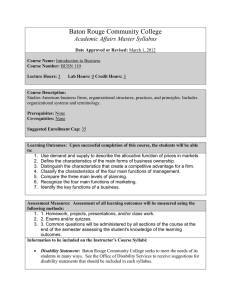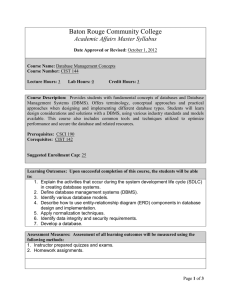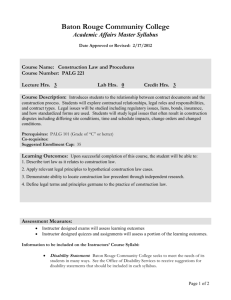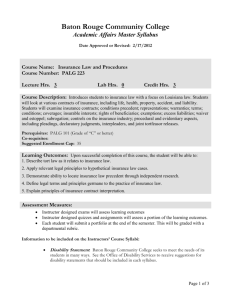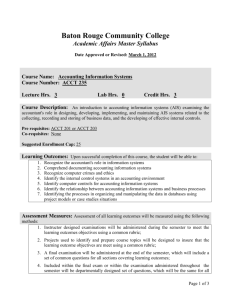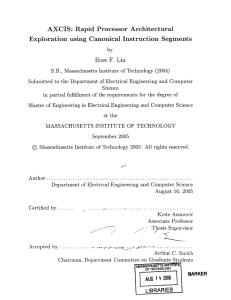CIST 250
advertisement
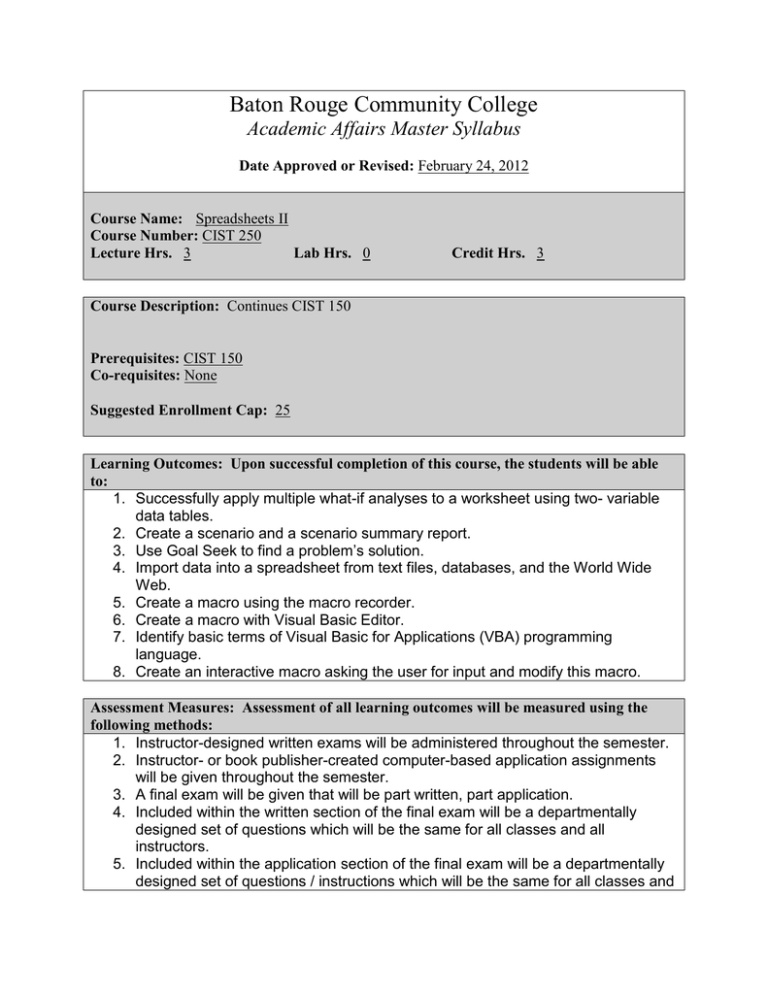
Baton Rouge Community College Academic Affairs Master Syllabus Date Approved or Revised: February 24, 2012 Course Name: Spreadsheets II Course Number: CIST 250 Lecture Hrs. 3 Lab Hrs. 0 Credit Hrs. 3 Course Description: Continues CIST 150 Prerequisites: CIST 150 Co-requisites: None Suggested Enrollment Cap: 25 Learning Outcomes: Upon successful completion of this course, the students will be able to: 1. Successfully apply multiple what-if analyses to a worksheet using two- variable data tables. 2. Create a scenario and a scenario summary report. 3. Use Goal Seek to find a problem’s solution. 4. Import data into a spreadsheet from text files, databases, and the World Wide Web. 5. Create a macro using the macro recorder. 6. Create a macro with Visual Basic Editor. 7. Identify basic terms of Visual Basic for Applications (VBA) programming language. 8. Create an interactive macro asking the user for input and modify this macro. Assessment Measures: Assessment of all learning outcomes will be measured using the following methods: 1. Instructor-designed written exams will be administered throughout the semester. 2. Instructor- or book publisher-created computer-based application assignments will be given throughout the semester. 3. A final exam will be given that will be part written, part application. 4. Included within the written section of the final exam will be a departmentally designed set of questions which will be the same for all classes and all instructors. 5. Included within the application section of the final exam will be a departmentally designed set of questions / instructions which will be the same for all classes and all instructors. 6. On the final exam, the written set of common questions and common application questions / instructions will cover all of the learning outcomes. These common questions may, at the instructor’s option, be used or not in determining the grade on the final exam. Information to be included on the Instructor’s Course Syllabi: Disability Statement: Baton Rouge Community College seeks to meet the needs of its students in many ways. See the Office of Disability Services to receive suggestions for disability statements that should be included in each syllabus. Grading: The College grading policy should be included in the course syllabus. Any special practices should also go here. This should include the instructor’s and/or the department’s policy for make-up work. For example in a speech course, “Speeches not given on due date will receive no grade higher than a sixty” or “Make-up work will not be accepted after the last day of class.” Attendance Policy: Include the overall attendance policy of the college. Instructors may want to add additional information in individual syllabi to meet the needs of their courses. General Policies: Instructors’ policy on the use of things such as beepers and cell phones and/or hand held programmable calculators should be covered in this section. Cheating and Plagiarism: This must be included in all syllabi and should include the penalties for incidents in a given class. Students should have a clear idea of what constitutes cheating in a given course. Safety Concerns: In some programs this may be a major issue. For example, “No student will be allowed in the safety lab without safety glasses.” General statements such as, “Items that may be harmful to one’s self or others should not be brought to class.” Library/ Learning Resources: Since the development of the total person is part of our mission, assignments in the library and/or the Learning Resources Center should be included to assist students in enhancing skills and in using resources. Students should be encouraged to use the library for reading enjoyment as part of lifelong learning. Expanded Course Outline: I. Review A. Review of spreadsheets B. Review of the Excel window C. Review of navigating in a workbook II. Data Tables and Scenario Management A. Creating and charting a one-variable data table B. Creating and charting a two-variable data table C. Using array formulas D. Using scenario manager E. Creating a scenario summary report F. Creating a scenario PivotTable report III. Using Solver A. Using Goal Seek B. Finding a solution using Solver C. Creating a Solver answer report D. Saving and loading Solver models E. Understanding Solver IV. Importing Data into a spreadsheet A. Working with text files B. Databases and queries C. Using the query wizard D. Working with external data and queries E. Creating a PivotTable and PivotChart from external data F. Creating a Web query G. Retrieving data from the Web H. Real-time data acquisition V. Enhancing Excel with Visual Basic for Applications A. Starting an Excel application B. Starting the Visual Basic editor C. Elements of the Visual Basic editor D. Working with Visual Basic sub procedures E. Introducing Visual Basic for applications F. Creating a program to switch fillers G. Retrieving information from the user H. Introducing control structures I. Creating a message box J. Creating customized toolbars and menus K. Customizing Excel screen elements

